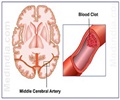Stroke 112, the life-saving stroke educational program goes global, revealed report.

‘Stroke 112, the life-saving stroke educational program contains the emergency number to call, and similar to FAST, in Stroke 112, each number corresponds with a warning sign: 1 uneven face (crooked mouth), 1 weak arm (arm weakness), and 2 incoherent lips (slurred speech).’





Stroke is the second leading cause of death worldwide and studies point to non-English speaking countries and regions having higher mortality and disability rates. This is partly due to delays in recognizing stroke occurrences, which hampers prompt emergency treatment. In the United States, the acronym FAST (Face, Arm, Speech, and Time) is used to help people recognize stroke symptoms and get stroke victims to a hospital quickly. However, the acronym does not translate well for non-English-speaking countries and regions, as it is difficult to remember the foreign language characters and their related meaning. To overcome language barriers, Renyu Liu, MD, PhD, an associate professor of Anesthesiology and Critical Care and a Center of Penn Global Health Scholar at the University of Pennsylvania Perelman School of Medicine, developed Stroke 112, which utilizes the universal emergency phone number: 112. Globally, there are about 80 countries and regions using 112 as the universal emergency phone number.
The researchers selected Taiwan as a non-English speaking region to test the acceptance of this simple, but potentially powerful, life-saving tool. Additionally, FAST has been used to educate people in Taiwan for fast stroke recognition for many years. The research team translated Stroke 112 into traditional Chinese and compared it to the Chinese translation of FAST through an initial online survey in Taiwan in August of 2017. In addition to gathering general demographic information--age, gender, and whether the responder was a medical professional--the survey asked which stroke educational program could be most easily remembered by people in Taiwan.
The Stroke 112 program was officially released to the public by the Stroke Treatment and Research Society of Taiwan in March of 2018, along with an educational video about Stroke 112 in Chinese. Two weeks later, the same survey was distributed electronically through social media and by a registered email list from the Taiwan Stroke Treatment and Research Society.
In the first round of the survey, before the public launch, 465 individuals (122 males and 343 females) between 11 and 80 years of age, consisting of 84 medical professionals and 381 nonmedical professionals, completed the survey. Among the survey responders, more than 54 percent thought that Stroke 112 would be easier for the people in Taiwan to remember than FAST.
Advertisement
Due to its higher acceptance than that of FAST, Stroke 112 could be used as the main or alternate stroke educational tool in non-English speaking environments. It could also improve stroke response times due to its direct link to an emergency phone number. Additionally, there is potential for increased international adoption of this program, as unlike FAST, the Stroke 112 strategy can be translated into almost any language. Even in some countries where 112 is not the primary emergency number, much like in the United States, a call to 112 can be redirected to the primary emergency phone number.
Advertisement
Liu and first author Jing Zhao, MD, PhD, of Minhang Branch, Zhongshan Hospital, Fudan University, created a similar program in China in 2016 called Stroke 120--in China, 120 is the specific medical emergency phone number used. The program was officially endorsed by the Chinese Stroke Association, which promoted the program nationwide and incorporated the strategy into its stroke management guidelines.
"The Stroke 120 program is now well established across China and with the high acceptance of Stoke 112 in Taiwan, we're looking to provide versions of Stroke 112 in other languages," Liu said. Liu and his research team are now working with international experts to promote Stroke 112 worldwide.
Source-Eurekalert















